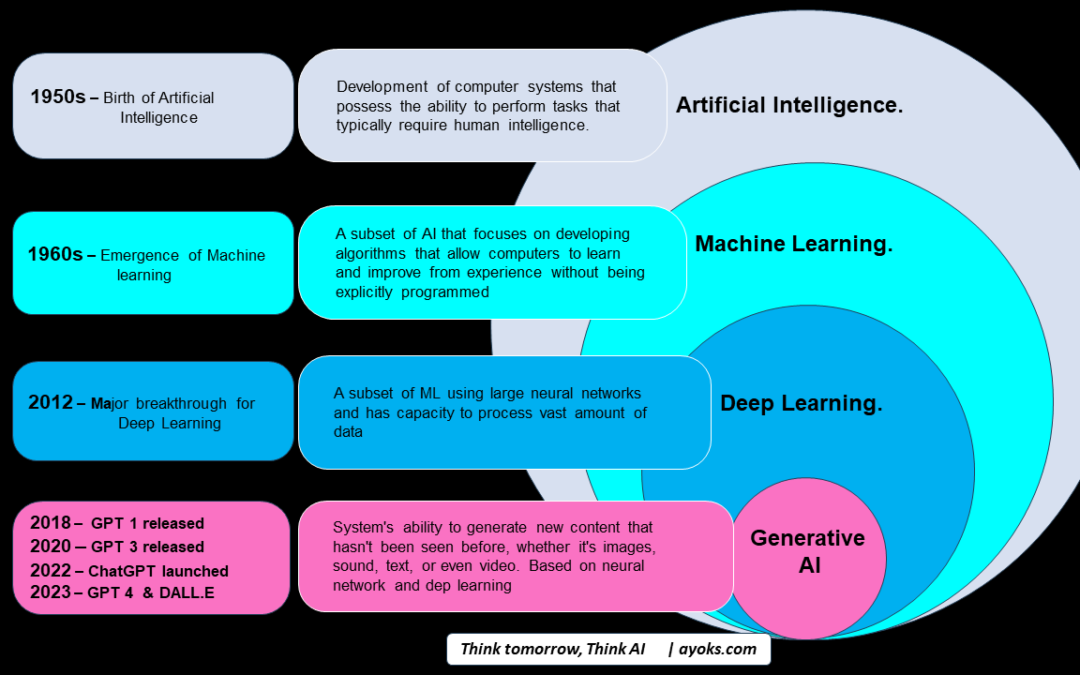Artificial Intelligence (AI) refers to the development of computer systems that possess the ability to perform tasks that typically require human intelligence. It encompasses a broad range of techniques, such as machine learning, natural language processing, computer vision, and robotics, which enable machines to perceive, reason, learn, and interact with their environment.
In very simple terms, think of it as having a digital assistant that can analyze data, recognize patterns, and make informed suggestions without getting tired or biased, ultimately helping businesses operate more efficiently and innovatively.
The field of AI continues to evolve, however the following core ideas serve as the building blocks for more advanced and specialized concepts.
Machine Learning (ML):
- Machine learning is a subset of AI that focuses on developing algorithms that allow computers to learn and improve from experience without being explicitly programmed. By analyzing vast amounts of data, machine learning algorithms can identify patterns, make predictions, and generate valuable insights that drive decision-making processes.
Neural Networks:
- Inspired by the human brain’s structure, these are interconnected layers of algorithms, called neurons, which feed data into each other. They can process and transmit signals in complex patterns, allowing for advanced pattern recognition.
Deep Learning:
- A subset of ML using large neural networks. It’s especially powerful for tasks like image and speech recognition due to its capacity to process vast amounts of data through its deep layers.
Natural Language Processing (NLP):
- The ability of AI to understand and generate human language. It’s the tech behind chatbots, voice assistants, and translation services.
Computer Vision:
- Allows machines to interpret and act upon visual data (images or videos). It’s employed in tasks like facial recognition, image tagging, and even medical image analysis.
Robotics:
- A field of engineering focused on the design and production of robots, which are autonomous or semi-autonomous machines that can perform tasks.
Reinforcement Learning:
- A type of machine learning where algorithms learn by taking actions and receiving rewards or penalties in return. It’s often used in training agents for games, simulations, and certain real-world scenarios.
Artificial General Intelligence (AGI):
- Sometimes referred to as “strong AI,” AGI denotes machines that can perform any intellectual task that a human can do. This contrasts with “narrow AI,” which is designed for a specific task.
Algorithm:
- Explanation: A set of specific instructions for completing a task. In the context of AI, algorithms often refer to the specific computational methods used to draw conclusions from data.
Robotic Process Automation (RPA):
- RPA involves using software robots or “bots” to automate highly repetitive and routine tasks previously performed by humans. This can be tasks like data entry, invoice processing, or basic data transformations. While RPA can be integrated with AI components to enhance its capabilities (like understanding unstructured data through NLP), basic RPA doesn’t involve any “learning” or “intelligence” but rather rule-based automations. When combined with AI, RPA can handle more complex tasks and enhance its capabilities beyond rule-based operations.
Generative AI (or Generative Adversarial Networks, GANs):
- Generative AI refers to a system’s ability to generate new content that hasn’t been seen before, whether it’s images, sound, text, or even video. GANs, a subset of generative AI, consist of two neural networks, the “generator” and the “discriminator,” that are trained together. This often used to produce high-resolution images, create artwork, or even generate realistic human faces.


Recent Comments